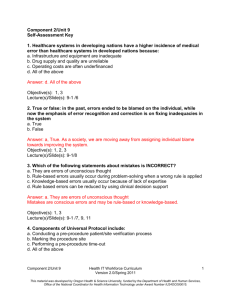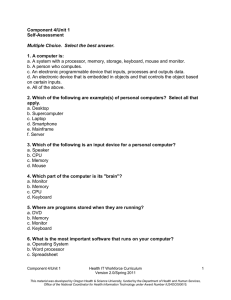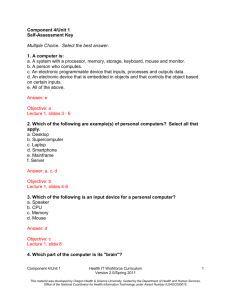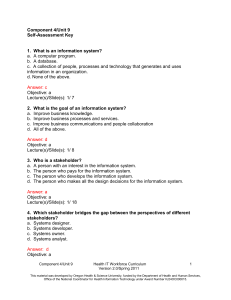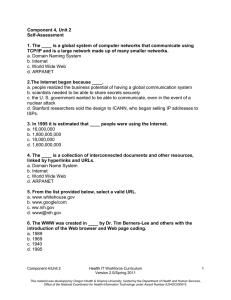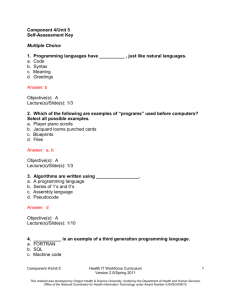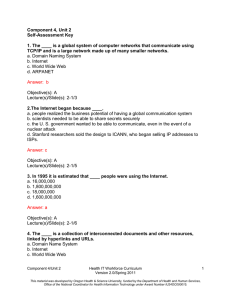Component 2/Unit 1 Self Assessment Key
advertisement
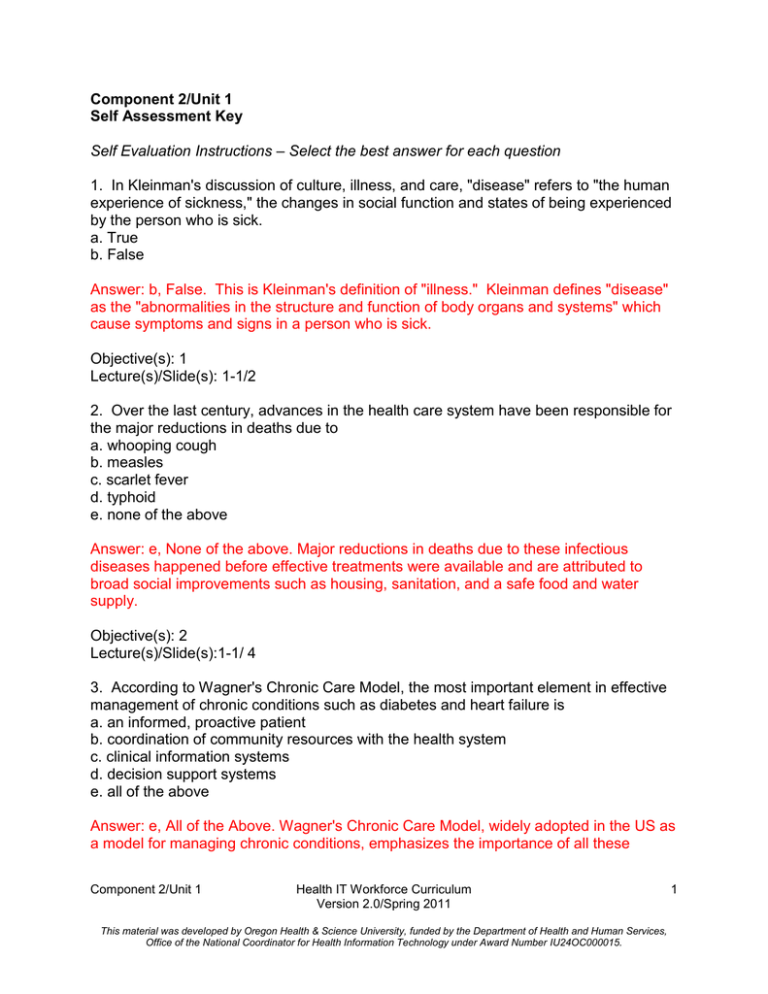
Component 2/Unit 1 Self Assessment Key Self Evaluation Instructions – Select the best answer for each question 1. In Kleinman's discussion of culture, illness, and care, "disease" refers to "the human experience of sickness," the changes in social function and states of being experienced by the person who is sick. a. True b. False Answer: b, False. This is Kleinman's definition of "illness." Kleinman defines "disease" as the "abnormalities in the structure and function of body organs and systems" which cause symptoms and signs in a person who is sick. Objective(s): 1 Lecture(s)/Slide(s): 1-1/2 2. Over the last century, advances in the health care system have been responsible for the major reductions in deaths due to a. whooping cough b. measles c. scarlet fever d. typhoid e. none of the above Answer: e, None of the above. Major reductions in deaths due to these infectious diseases happened before effective treatments were available and are attributed to broad social improvements such as housing, sanitation, and a safe food and water supply. Objective(s): 2 Lecture(s)/Slide(s):1-1/ 4 3. According to Wagner's Chronic Care Model, the most important element in effective management of chronic conditions such as diabetes and heart failure is a. an informed, proactive patient b. coordination of community resources with the health system c. clinical information systems d. decision support systems e. all of the above Answer: e, All of the Above. Wagner's Chronic Care Model, widely adopted in the US as a model for managing chronic conditions, emphasizes the importance of all these Component 2/Unit 1 Health IT Workforce Curriculum Version 2.0/Spring 2011 This material was developed by Oregon Health & Science University, funded by the Department of Health and Human Services, Office of the National Coordinator for Health Information Technology under Award Number IU24OC000015. 1 elements in an integrated systems approach. Objective(s): 2,5 Lecture(s)/Slide(s): 1-1/5 4. Because it is part of our day-to-day existence, our own cultural beliefs, values, and assumptions are most obvious to us. a. True b. False Answer: b, False. Culture is what you take for granted, and our own cultural beliefs, values and assumptions most often become apparent when we interact with different cultures. Objective(s): 3,4 Lecture(s)/Slide(s): 1-1/6,7,8 5. The traditional view of culture as a "closed, coherent system of meaning and action in which an individual always participates " still holds true today. a. True b. False Answer: b, False. The classic view, if it ever applied to anything, applied only to geographically isolated societies. A contemporary view is that cultures are always plural, partial, and relative. Objective(s): 3 Lecture(s)/Slide(s): 1-1/6,7,8 6. Agar states that we understand other cultures by examining "rich points," which are a. beliefs and values of those with highest status or wealth in a culture b. behaviors or observations that highlight cultural differences c. phenomena that exemplify the diversity or richness in a particular setting d. none of the above Answer: b. "Rich points" are behaviors or phenomena that we tend to notice because they highlight differences between cultures. Objective(s): 6 Lecture(s)/Slide(s): 1-2/10 7. "Just Culture" refers to organizations with all the following characteristics except: a. members believe they are safe when questioning existing practices or concerns b. members share an overall commitment to quality Component 2/Unit 1 Health IT Workforce Curriculum Version 2.0/Spring 2011 This material was developed by Oregon Health & Science University, funded by the Department of Health and Human Services, Office of the National Coordinator for Health Information Technology under Award Number IU24OC000015. 2 c. emphasis on sticking to procedure and consequences for any errors d. extensive formal and informal information sharing in response to mishaps or events. Answer: c. Rigid adherence to existing procedure and heavy emphasis on accountability and punishment tend to produce the opposite of "Just Culture" and lead to distrust, fear, and silence when mishaps or near misses occur. Objective(s): 5,6 Lecture(s)/Slide(s): 1-1/13,14 8. Based on a modern concept of culture, we can expect the culture of health care settings like hospitals and medical centers to be a. primarily about professionalism and the authority of specialized knowledge b. emphasizing caring in a holistic manner for each individual as a person c. mainly concerned with efficiency and productivity in business processes d. none of the above Answer: d, none of the above. According to the modern concept of culture as plural, partial, and relative, we would expect all of these cultural elements, and others, to coexist in a hospital or medical center. Objective(s): 5,6,9 Lecture(s)/Slide(s): 1-1/15 Fill in the blank with the word or phrase from lecture that best fits: 9. The notion that patients (or clients, or workers) will feel safe, feel they can express their cultural identity, and feel respected and listened to is referred to as ________ Answer: Cultural safety Objective(s): 5 Lecture(s)/Slide(s): 1-1/15,16 10. Because any given individual, in a health care setting or elsewhere, generally partakes of or expresses multiple different cultures or cultural identities, we say that culture is ________ Answer: Partial. Culture, according to the modern view, is always relative, partial, and plural Objective(s): 6 Lecture(s)/Slide(s): 1-2/8 Component 2/Unit 1 Health IT Workforce Curriculum Version 2.0/Spring 2011 This material was developed by Oregon Health & Science University, funded by the Department of Health and Human Services, Office of the National Coordinator for Health Information Technology under Award Number IU24OC000015. 3
